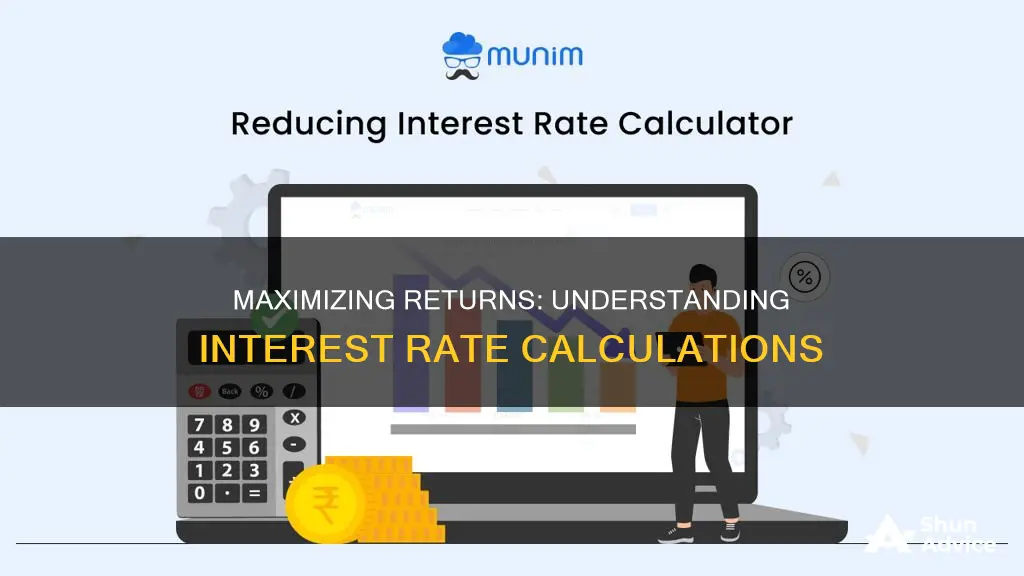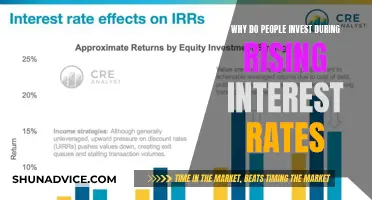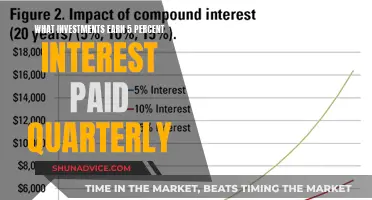
Interest rates are the amount charged by lenders to borrowers for the use of money, expressed as a percentage of the principal, or original amount borrowed. There are different types of interest rates, such as simple interest and compound interest, and different ways to calculate them. This article will explain how to determine the interest rate on an investment, including the formulas and calculations involved, and how to use an interest rate calculator to find the information you need.
| Characteristics | Values |
|---|---|
| Formula for simple interest rate | r = (1/t)(A/P - 1) |
| Formula for total amount | A = P(1 + rt) |
| Formula for rate as a percentage | r x 100 = R |
What You'll Learn

Calculating simple interest
To calculate simple interest, you need to know the principal amount of money invested, the interest rate, and the number of time periods. The interest rate is in decimal form, so if you have a percentage, divide it by 100. The formula to calculate simple interest is A = P(1 + rt), where A is the total amount of money at the end of the investment, P is the principal amount, r is the interest rate, and t is the number of time periods.
For example, if you invest $22,000 for 4 years at a simple interest rate of 5.45%, the formula would be A = $22,000(1 + 0.0545*4), which equals $26,800.
You can also use this formula to find the interest rate. For example, if you want to have an investment of $26,800 after 4 years with an original principal of $22,000, the formula would be r = (1/4)((26,800 / 22,000) - 1), which equals 5.45%.
It's important to note that the total interest accrued over time may change if you make extra deposits or withdrawals.
Investing for Compound Interest: Does it Work?
You may want to see also

Using an interest rate calculator
There are several ways to determine the interest rate on an investment. One way is to use an interest rate calculator. This can be used to determine the real interest rates on loans with fixed terms and monthly payments. For example, if a car dealer only provides monthly payment information and the total price without including the actual rate on the car loan, an interest rate calculator can be used to calculate the interest rate.
To calculate the interest on investments, you can use an interest calculator or a compound interest calculator. An interest calculator can be used to find the total principal plus interest, principal only, and interest only. It can also calculate the simple interest rate, or time period in days, weeks, months, quarters, and years. Input any three variables of the total amount, principal, interest rate, or time period, and the calculator can find the missing variable. The formula to find the simple interest rate is r = (1/t)(A/P - 1). The interest rate r is in decimal form, so note that r is R% divided by 100. For example, say you want an investment where at the end of the investment time period the total principal plus interest A = $26,800. The investment term is t = 4 years, and the original principal P = $22,000. Using the formula for the simple interest rate r = (1/t)(A/P - 1), plug the known variables into the equation. r = (1/t)(A/P - 1) r = (1/4)((26,800 / 22,000) - 1) r = (0.25)(1.218 - 1) r = (0.25)(0.218) r = 0.0545. Multiply r by 100 to get R as a percentage: R = 0.0545 * 100 = 5.45%. So, for a total accrued amount of $26,800 with an original principal of $22,000 and a term of 4 years, the simple interest rate you'll need is 5.45%.
With a deposit account, like a savings account or CD, the interest rate is usually easy to find. This calculation is much more useful for investment vehicles whose returns vary from year to year, such as stocks and mutual funds. For example, say you invested $10,000 into a mutual fund three years ago, and your account's value is now $12,500. Divide $12,500 by $10,000 and raise the result to the one-third power using your calculator's exponent key, and then subtract one.
Investment Loan Interest: Higher or Lower?
You may want to see also

Finding the interest rate on a deposit account
Interest rates on deposit accounts are usually easy to find. However, if you want to calculate the interest rate on an investment, you can use the following formula: r = (1/t)(A/P - 1). In this formula, r is the interest rate, t is the number of time periods, A is the total amount, and P is the principal amount of money invested. The interest rate r is in decimal form, so you need to divide the interest rate percentage by 100.
For example, let's say you want to have an investment where at the end of the investment time period, the total principal plus interest is $26,800. The investment term is 4 years, and the original principal is $22,000. You can plug these numbers into the formula: r = (1/4)((26,800 / 22,000) - 1). After performing the calculations, you'll find that the simple interest rate you need is 5.45%.
It's important to note that the total interest accrued over time may change if you make extra deposits or withdrawals. There are also online calculators available that can help you find the simple interest rate, as well as the time period in days, weeks, months, quarters, or years.
Dollar Interest Rate Changes: Impact on Your Investments
You may want to see also

Calculating the interest rate on a loan
To calculate the interest rate on a loan, you will need to know the total amount of money borrowed, the original amount borrowed (also known as the principal), the length of the loan term, and the monthly payments.
The formula for calculating the interest rate on a loan is r = (1/t)(A/P - 1), where r is the interest rate, t is the length of the loan term, A is the total amount of money borrowed, and P is the original amount borrowed.
For example, let's say you borrow $22,000 for a term of 4 years, and at the end of the term, you owe a total of $26,800. Using the formula, we can calculate the interest rate as follows: r = (1/4)((26,800 / 22,000) - 1) r = (0.25)(1.218 - 1) r = (0.25)(0.218) r = 0.0545. To express the interest rate as a percentage, we multiply this amount by 100: R = 0.0545 * 100 = 5.45%. So, the interest rate on this loan is 5.45%.
It's important to note that this calculation assumes a simple interest rate, where the interest is calculated based on the original principal amount only. Compound interest, on the other hand, takes into account the interest that accumulates over time, resulting in a larger total amount owed.
Interest Rate Changes: Impact on Consumption and Investment Decisions
You may want to see also

Understanding the difference between interest rates
Interest rates are a percentage of the principal, or the original amount borrowed. They are the amount charged by lenders to borrowers for the use of money.
When it comes to investments, there are two types of interest rates to consider: simple interest and compound interest. Simple interest is calculated as the product of the principal amount, the interest rate, and the number of time periods. The formula for simple interest is A = P(1 + rt), where A is the total principal plus interest, P is the principal amount, r is the interest rate, and t is the number of time periods.
Compound interest, on the other hand, is calculated by multiplying the principal amount by the interest rate for each time period. The formula for compound interest is A = P(1 + r)^t, where A is the total principal plus interest, P is the principal amount, r is the interest rate, and t is the number of time periods.
To determine the interest rate on an investment, you can use a simple interest calculator or a compound interest calculator. These calculators can help you find the missing variable in the formula by inputting the other known variables. For example, if you know the total amount, principal, and time period, you can use the calculator to find the interest rate.
It's important to note that the total interest accrued over time may change if you make extra deposits or withdrawals from your investment account. Therefore, it's crucial to consider the potential impact of these transactions on your overall investment strategy and interest rate calculations.
Interest's Impact: Understanding Investment Gains and Losses
You may want to see also
Frequently asked questions
You can calculate the interest rate on your investment by using the formula r = (1/t)(A/P - 1). In this formula, r is the interest rate, t is the number of time periods, A is the total amount and P is the principal amount of money invested.
To express the interest rate as a percentage, multiply the decimal figure by 100.
You can use an interest rate calculator to determine the real interest rate on your investment if you only have monthly payment information.







